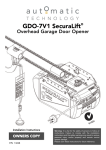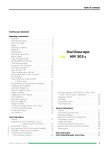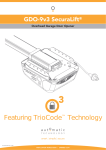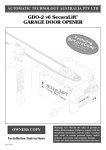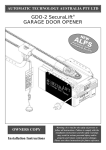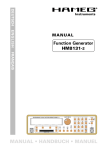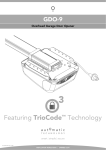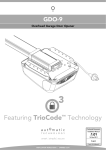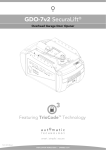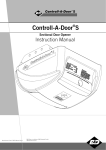Download Automatic Technology GDO-9 Installation manual
Transcript
® GDO-9V1 SecuraLift Overhead Garage Door Opener Installation Instructions OWNERS COPY P/N 13210 WARNING It is vital for the safety of persons to follow all instructions. Failure to comply with the installation instructions and the safety warnings may result in serious personal injury and/or property and remote control opener damage. Please save these instructions for future reference. TABLE OF CONTENTS Safety Precautions------------------------------------------------3 Opener Features----------------------------------------------------4 Operating Controls-------------------------------------------------5 Kit Contents----------------------------------------------------------7 Installation------------------------------------------------------------9 C-rail Assembly-----------------------------------------------------------9 Determine Door Type----------------------------------------------------11 Mounting - Track Type Door-------------------------------------------12 Mounting - Spring Loaded Door--------------------------------------13 Mounting Door Bracket & Arms---------------------------------------14 Easy Access Transmitter-----------------------------------------------15 Programming the Opener---------------------------------------16 Setting Travel Limits - Control Panel--------------------------------16 Setting Travel Limits - Transmitter-----------------------------------17 Safety Obstruction Force Test -------------------------------18 Coding Transmitters----------------------------------------------19 Door-------------------------------------------------------------------------19 Courtesy Light------------------------------------------------------------19 Vacation Mode------------------------------------------------------------19 Pet Mode-------------------------------------------------------------------19 Storing Transmitter From Remote Loc.-----------------------------20 Erasing Transmitter Codes---------------------------------------------20 Accessories----------------------------------------------------------21 Photo Electric Beam-----------------------------------------------------21 Auto-Close------------------------------------------------------------------21 Battery back up installation---------------------------------------------22 Final Set Up----------------------------------------------------------23 Courtesy Light Time-----------------------------------------------------23 Pet Mode Door Height--------------------------------------------------23 Transmitter Wall Bracket-----------------------------------------------23 Re-Initialising--------------------------------------------------------------23 Parameter-------------------------------------------------------------24 Door Status Indicators---------------------------------------------------24 Quick Reference Guide-------------------------------------------------24 System Specification---------------------------------------------25 Factory Default Settings------------------------------------------------25 Trouble Shooting Guide-----------------------------------------26 Maintenance Record----------------------------------------------26 Parts List--------------------------------------------------------------27 Warranty---------------------------------------------------------------28 Automatic Technology Australia Pty Ltd to the extent that such may be lawfully excluded hereby expressly disclaims all conditions or warranties, statutory or otherwise which may be implied by laws as conditions or warranties of purchase of an Automatic Technology Australia Pty Ltd Garage Door Opener. Automatic Technology Australia Pty Ltd hereby further expressly excludes all or any liability for any injury, damage, cost, expense or claim whatsoever suffered by any person as a result whether directly or indirectly from failure to install the Automatic Technology Australia Pty Ltd Garage Door Opener in accordance with these installation instructions. SAFETY PRECAUTIONS Warning - It is vital for the safety of persons to follow all instructions. Failure to comply with the following Safety Rules may result in serious personal injury and/or property damage. Caution: If your garage has no pedestrian entrance door, an emergency access device should be installed. This accessory allows manual operation of the garage door from outside in case of power failure. The unit should be installed so that it is protected from the elements. It should not be exposed to water or rain. It is not to be immersed in water or sprayed directly by a hose or other water carrying device. For ADDITIONAL SAFETY protection we STRONGLY recommend the fitting of a Photo Electric Beam. In most countries Photo Electric Beams are mandatory on all garage doors fitted with automatic openers. For a small additional outlay ATA recommends that Photo Electric Beams be installed with the automatic opener ensuring additional safety and peace of mind. The garage door must be WELL BALANCED. Sticking or binding doors must be repaired by a qualified garage door installer prior to installation of the opener. Frequently examine the installation, in particular cables, springs and mountings for signs of wear, damage or imbalance. DO NOT use if repair or adjustment is needed since a fault in the installation or an incorrectly balanced door may cause injury. DO NOT attempt to repair the door yourself as hardware is under extreme tension. DO NOT operate the garage door opener unless the garage door is in full view and free from objects such as cars and children/people. Make sure that the door has finished moving before entering or leaving the garage. REMOVE OR DISENGAGE all garage door locks and mechanisms prior to installation of the opener. DO NOT operate the garage door opener when children/persons are near the door. Children must be supervised near the garage door at all times when the door opener is in use. SERIOUS PERSONAL INJURY and/or property damage can result from failure to follow this warning. Connect the garage door opener to a properly EARTHED general purpose 240V mains power outlet installed by a qualified electrical contractor. DISCONNECT THE POWER CORD from mains power before making any repairs or removing covers. Only EXPERIENCED service personnel should remove covers from the garage door opener. DO NOT allow children to operate the garage door opener. SERIOUS PERSONAL INJURY and/or property damage can result from failure to follow this warning. When using auto close mode, a PHOTO ELECTRIC BEAM must be fitted correctly and tested for operation at regular intervals. EXTREME CAUTION is recommended when using auto close mode. ALL SAFETY RULES must be followed. Regularly check to make sure that the SAFETY OBSTRUCTION FORCE is working correctly, and is TESTED (by placing a 50mm high object on the floor) and set as per the Installation Instructions Manual. Failure to follow the manual could result in SERIOUS PERSONAL INJURY and/or property damage. This test must be repeated at regular intervals and the necessary adjustments made as required. In order for the garage door opener to SENSE an object obstructing the door way, some FORCE must be exerted on the object. As a result the object, door and/or person may suffer DAMAGE or INJURY. DO NOT disengage the door opener to manual operation with children/persons or any other objects including motor vehicles within the doorway. If the power supply cord is damaged, it MUST be replaced by an ATA service agent or suitably qualified person. The door opener is not intended for use by young children or infirm persons without adequate supervision. Children should be supervised to ensure that they do not play with the remote transmitters or the opener. Make sure that the door is fully open before driving in or out of the garage and fully closed before leaving the driveway. Make sure that remote controls are kept out of reach of children. Keep hands and loose clothing CLEAR of the door and door opener at all times. Install the wall switch or wall mounted transmitter in a location where it is out of reach of children and the garage door is visible. 3 FEATURES Thank you for purchasing the ATA GDO-9 Automatic Garage Door Opener. This opener is designed to suit sectional overhead and one piece tilt up doors. The components and materials used in this opener are of the latest technology and highest quality. Listed below are some of the many features. OPERATION To open or close the door simply press the hand held transmitter, the wall mounted transmitter, or optional wall switch for two seconds. During an open or close cycle the door can be stopped by pressing the button while the door is in motion. The next actuation will move the door in the opposite direction. HOPPING CODE Every time a transmission is made from the remote transmitter a new security code is generated. The number of possible code combinations is over 4.29 billion. This greatly enhances the security of the system. Code “grabbing” is made a thing of the past. ALPS ( AUTOMATIC LIMITS POSITIONING SYSTEM) The ALPS system does away with manual adjustment of the doors’ limits position using mechanical parts, such as cams and micro switches. During installation the hand held transmitter can be programmed to set the door limits positions. ISS (INTELLIGENT SAFETY OBSTRUCTION SYSTEM) Whilst performing a close cycle the door will automatically reverse if it should hit an obstacle or is restricted in some manner. The amount of force the door should encounter before reversing is automatically adjusted by the control system during the initialisation of the opener. The door will also stop if restricted whilst opening. The safety obstruction force should be checked at least once a month. See installation manual for instructions. SECURITY CODE STORE The gdo-9 securalift® Garage Door Opener uses state of the art technology in storing your selected transmitter security codes Up to 24 different transmitters can be stored in the openers memory. OVER LOAD INDICATOR When the maximum opening and closing capacity of the opener is exceeded an audible beeper will sound to indicate that an overload has occurred. AUTO COURTESY LIGHT The opener’s courtesy light illuminates automatically whenever the door is activated. The light can also be switched on and off without operating the door. This is done by pressing the button on any transmitter which has been coded to operate the light. The light will stay on for approximately three minutes then switch off. This time is also adjustable. BATTERY BACK UP (OPTIONAL) The opener has provision to include a battery back up module. This is an ideal addition if the garage door is the only entrance to the garage or if the area is prone to power cuts. Note: If the panel lift door is the only entrance to the garage and a battery back up kit is not fitted to the opener - a keyed cable release should be fitted to the exterior of the garage. 4 VACATION MODE A transmitter can be programmed to block out all other transmitters that have been programmed into the opener’s memory. Vacation mode is ideal for homes with non-permanent tenancy or when the door is to be left idle for long periods of time. PET (PEDESTRIAN) MODE A transmitter can be programmed to open the door partially so that the family pet can enter and exit the garage at any time. If required, you may also wish to open the door to a height suitable only for pedestrian access. The opening height is adjustable. AUTO CLOSE MODE The opener can be programmed to automatically close after an open cycle. It is compulsory to install a photo electric beam if this mode is selected, otherwise the door may cause personal injury or damage to property. Auto close time is adjustable. PHOTO ELECTRIC BEAM (OPTIONAL) The opener has an input for a photo electric beam to be connected for extra safety protection and use of the auto close mode. MANUAL OPERATION The opener is equipped with a unique manual disengaging device. If the power to the opener is disrupted for any reason the door can be put into manual mode by pulling down on the string handle on an angle towards the door. This will allow you to manually open or close the door. To re-engage the opener pull the string handle away from the door. EASY ACCESS TRANSMITTER Inside the manual release handle is a transmitter designed to be in easy reach so that the garage door can be operated without having to stretch to reach the oprate button on the control panel. OPERATING CONTROLS 1. P. E. SHUNT. The shunt has to be removed when connecting a Photo Electric Beam. NOTE: P.E. SHUNT must not be removed otherwise the opener will not function correctly. Remove only when a P.E beam is to be connected. 2. Terminal is used to connect 24vac to the control board 3. 10 amps fuse is to protect the electronic circuit board 4. this connector is used to connect battery charger sby3 to the opener 5. dc 24v motor connects to this connector. 6. OPERATE (YELLOW) button is used during installation to test the open, stop and close cycles for the opener. The opener has to be initialised by the Reset button before the oprate button becomes operable. 7. PLUS ( + ) (GREEN) button is used During installation to help set the open limit position. Pressing and holding this button will move the door in the open direction. Movement stops when the button is released. 8. PROG INPUT is used for the connection of the ATA Handheld Programmer for the purpose of editing control and receiver functions. 9. LED light module connector is used to connect 24v led light module 10. FORCE MARGIN SET Button The obstruction force pressure is set automatically by the opener during installation. The pressure can be adjusted manually using the Force Margin Set button . Holding the Force Margin Set button and pressing the Plus (+) or Minus (-) button will increase or decrease the amount of force. The Force Margin Set is only ever used if other environmental factors (wind, etc.) effect the operations of the door/opener. 11. OPEN LIMIT LED (green) the led is very helpful during installation. It illuminates and flashes when the door is opening and remains steady on when the open limit position has been reached. 12. AUTO CLOSE TIME button is used to adjust the auto close time. While holding in the auto close button and then pressing the open button the time is increased. Each press will increase the time by 5 seconds. Pressing the close button will decrease the time. 13. CLOSE LIMIT LED (red) the led is very helpful during installation. It illuminates and flashes when the door is closing and remains steady on when the close limit position has been reached. 14. MINUS (-) (RED) button is used during installation to help set the close limit position. Pressing and holding this button will move the door in the close direction. Movement stops when the button is released. 5 15. DOOR STATUS LED (Yellow) 16. DOOR CODE (BLUE)button is used for storing or erasing the transmitter button you wish to use to command the door to open, stop or close. 17. CODING LED light flashes when a code is being stored or when a transmitter button is pressed. 18. LIGHT CODE button is used for storing or erasing the transmitter button (code) you wish to use to switch the courtesy light on the opener on or off. 19. SET (ORANGE) button is used during the installation phase together with the Open and Close buttons to set the door limit positions. The Set button is also used to re-initialise the Opener. 20. . Terminal Block. 24V PWR is used to power devices such as photo electric beams. PE (Input) for photo electric beam for safety and auto-close function. LGT (Input) allow hard wired external trigger for the opener’s courtesy light. O/S/C INPUT is used for the connection of a wired switch (momentary contact). This switch can then be used to open, stop or close the door. Install the wall switch in a location where the switch is out of reach of children and the garage door is visible. OPERATING CONTROLS FIG. 1 2 3 5 4 6 7 1 8 21 9 20 19 10 17 1) 2) 3) 4) 5) 6) 7) 8) 9) 10) P.E. SHUNT 24V POWER INPUT CONNECTOR 10 AMP FUSE SBY-3 BATTERY BACK UP CONNECTOR MOTOR CONNECTOR OPERATE (YELLOW) BUTTON PLUS (+) (GREEN) BUTTON PG-3 PROGRAMMER CONNECTOR COURTESY LIGHT MODULE FORCE MARGIN BUTTON 15 11) 12) 13) 14) 15) 16) 17) 18) 19) 20) 21) 6 12 14 16 18 13 OPEN LIMIT LED AUTO CLOSE TIME BUTTON CLOSE LIMIT LED MINUS ( - ) (RED) BUTTON STATUS LED DOOR CODE (BLUE) BUTTON CODE SET LED LIGHT CODE BUTTON EASY ACCESS TRANSMITTER SET (ORANGE) BUTTON PE, O/S/C CONNECTOR 11 KIT CONTENTS FIG. 2 GDO-9V1 AUTO OPENER CH P/N 00090 ITEM QUANTITY GDO-9 SECTIONAL DOOR OPENER DRIVE UNIT------------------------------------------------------1 EASY ACCESS TRANSMITTER EAT-1 (NOT INCLUDED IN SOME MODELS) -----------------1 KEY RING TRANSMITTER PTX-4 PACK--------------------------------------------------------------------1 (pack includes two keyring transmitters two batteries and one wall mount bracket for ptx4 transmitter) C-RAIL PACK--------------------------------------------------------------------------------------------------------1 DOOR ATTACHMENT ARMS------------------------------------------------------------------------------------2 ACCESSORY PACK------------------------------------------------------------------------------------------------1 INSTALLATION MANUAL-----------------------------------------------------------------------------------------1 7 KIT CONTENTS ITEMS one piece c-rail assembly See fig 3 QTY 1 FIG. 3 Note chain in one piece rail has been tensioned by the factory Do not adjust the tension of the chain IMPORTANT NOTE If modification to the track length required,adjustment must be made only from power head side. C-RAIL CH-1P VP1 ASSY P/N 01651 ITEMS QTY FIG. 4 GDO-9 SECTIONAL DOOR OPENER DRIVE UNIT---1 KEY RING TRANSMITTER PTX-4 PACK----------------1 (pack includes two keyring transmitters two batteries and one wall mount bracket for ptx4 transmitter) DOOR ATTACHMENT ARMS--------------------------------2 ACCESSORY PACK--------------------------------------------1 See fig 4 C-RAIL CH-1P VP1 ASSY P/N 01651 ITEMS QTY C-Rail knock down assembly---------------1 See fig 5 FIG. 5 C-RAIL CH-KD 3P VP1 ASSY P/N 01650 8 C-RAIL ASSEMBLY FIG. 6 Step 1 Unpack and assemble the C -rail as shown above in fig 6 9 C-RAIL ASSEMBLY Step 2 Locate and insert the shaft of drive unit into sprocket as shown in fig 7 FIG. 7 Step 3 Fix the two track brackets as shown in fig 8 fix with four screws supplied in accessory pack FIG. 8 10 DETERMINE THE DOOR TYPE Step 4 Determine which type of garage door you have as illustrated below. (Fig. 9 - 11). FIG. 9 l For a sectional (panel) door on tracks (Fig. 9) proceed with the installation from Step 5. l For a one piece door on tracks (Fig. 10) proceed with the installation from Step 5. l For a one piece door without tracks (on springs) (Fig. 11) proceed with the installation from Step 9.page 13 FIG. 10 FIG. 11 one piece door without track 11 MOUNTING OPENER FOR TRACK TYPE DOOR STEP 5 Open the door and find the highest point of travel of the top door panel. Using a level, transfer this height to the wall above the door (Fig. 12) and mark a line 60mm above it. FIG. 12 Determine the centre point on the wall above and on top of the door. Then draw two (2) lines 21.5mm on each side of the centre point. (Fig. 13). STEP 6 The wall bracket should be mounted 60mm above highest point of the doors travel, 21.5mm from the centre point. (Fig. 13). If the wall bracket is mounted onto concrete or brick wall, use 8mm or 5/6 loxins or dynabolts. If mounting onto wooden lintel or beam, use wood screw #20 or equivalent minimum 50mm long. FIG. 13 WARNING: MAKE SURE CONCRETE, BRICK WALL OR TIMBER LINTEL ARE SOLID AND SOUND SO AS TO FORM A SECURE MOUNTING PLATFORM. STEP 7 When the wall bracket is firmly secured in its proper position, attach the support c-rail assembly to wall bracket with 90mm long clevis pin and secure with supplied snap pin, (Fig. 14) leaving drive unit in its packing box for protection during installation. STEP 8 Raise the drive unit from the packing box and support it in a horizontal position with a step ladder, then open the garage door. Rest the opener on the open door and use a scrap piece of wood to bring it to horizontal level. Line up the track perpendicular to the wall. FIG. 14 Secure to the ceiling above drive unit mounting holes, with perforated angle (not supplied). A representative mounting is shown. (Fig. 15) Connect angle and drive unit with two flat perforated strips of angle (not supplied) with M8 x 20mm screws, and nuts . Strips should not extend more than 18mm below centre of drive unit mounting holes. (FIG. 15). WARNING: THE OPENER MUST BE SECURELY FASTENED TO A STRUCTURAL SUPPORT OF THE GARAGE. FAILURE TO FASTEN THE OPERATOR CORRECTLY MAY LEAD TO OPENER FAILURE CAUSING SERIOUS PERSONAL INJURY AND/OR PROPERTY DAMAGE. FIG. 15 12 MOUNTING OPENER FOR SPRING LOADED DOOR STEP 9 Determine the centre of the door and mark this location on the wall above and on top of the door. Then draw two (2) lines 21.5mm on each side of the centre point. (Fig. 16). FIG. 16 WARNING: MAKE SURE CONCRETE, BRICK WALL OR TIMBER LINTEL ARE SOLID AND SOUND SO AS TO FORM A SECURE MOUNTING PLATFORM. STEP 10 Raise the door to open position. Rest the opener on the top edge of the door with end of the c-rail against the wall and drive unit supported level with the lowest point of the open door. (Fig. 17). Note: Do not slide opener c-rail on face of the door when it is open as it may damage the door surface. FIG. 17 Secure the drive unit to the ceiling with perforated angle (not supplied). A representative mounting is shown. (Fig. 15). Connect angle and drive unit with two flat perforated strips of angle (not supplied) with M8 x 20mm screws and nuts. The strips should not extend more than 18mm below centre of drive unit mounting holes. (Fig. 15). Do not lock screws at this stage. STEP LADDER STEP 11 Close the door slowly. The opener c-rail will be elevated by the top edge of the door as it moves. Stop the door when it is at its highest point of travel. (Fig. 18). FIG. 18 C RAIL Allow 25mm additional height for clearance between the door and the track. Support c-rail in this position and then close the door. (Fig. 18) This will be the height to mount the wall bracket. The top of the door must not touch the tube. 25mm HIGHEST POINT OF DOOR TRAVEL DOOR STEP LADDER WARNING: THE OPENER MUST BE SECURELY FASTENED TO A STRUCTURAL SUPPORT OF THE GARAGE. FAILURE TO FASTEN THE OPERATOR CORRECTLY WILL LEAD TO POSSIBLE OPENER FAILURE CAUSING SERIOUS PERSONAL INJURY AND/OR PROPERTY DAMAGE. the opener can be fastened to the roof by drilling a hole in the centre of the c-rail and driving a bolt through it into structural timber support. the height of bolt head must not exceed 6 mm. see fig 18a ALUMINIUM RAIL SHUTTLE VP2 ASSEMBLY 13 6mm MAX (HEIGHT OF BOLT HEAD) DRILL HOLE AT CENTER OF TRACK (RECOMMENDED BOLT SIZE M6 OR M8) FIG. 18A MOUNTING DOOR BRACKET AND ARMS STEP 12 With the centre point of the door located, mark a line through the centre of the wall bracket onto the header wall (above the door). Using the bracket as a template mark a minimum of two holes and drill with appropriate size bit. If necessary the wall bracket can be anchored using more than two holes for a more secure fitting. FIG. 19 If the wall bracket is mounted onto concrete or brick wall, use M8 or 5/6 loxins or dynabolts. If mounted onto wooden lintel or beam, use wood screws #20 or equivalent, minimum 50mm long. Attach the wall bracket to the c- assembly with 90mm long clevis pin (Fig. 19) and secure by snap pin. MOUNTING DOOR BRACKET AND ARMS FIG. 20 STEP 13 The door bracket comes in two parts. The bottom plate with two mounting holes is used on its own for any one piece doors. The top plate is placed over the bottom plate and uses 4 mounting holes for extra strength. This is used on sectional doors. (See Fig. 20). Mount the door bracket to the centre line of the door (Fig. 20), using M6 or equivalent screws (not supplied) Alternatively it can be welded on steel doors. Note: As various types of doors exist, if in doubt about the strength of the door, reinforcement may need to be added to the frame of the door panel where necessary. Damage to the door panel may occur if the bracket is installed incorrectly on a panel with insufficient strength. The door opener warranty does not cover damage caused by the opener to the door and/or door panel. FIG. 21 STEP 14 Assemble bent and straight arm with screws, plain and spring washer and nuts supplied in accessory pack. (Fig. 21) Then connect assembled arm to the door bracket and the trolley by clevis pin and snap pin. Trolley must be in disengage position. Always use both the bent and straight arm. If installing on a door with bad wave action, lengthening the arm even further will assist the door operation by reducing the wave action. 14 EASY ACCESS TRANSMITTER EASY ACCESS TRANSMITTER FIG. 22 The Easy Access Transmitter is prepared ready for use with the battery pre-installed. Before the transmitter can be operational, the transmitter code has to be stored into the openers memory. To store the code refer to Step 18.1 on page 19. REMOVING THE COVER TO REPLACE BATTERY 1. Rotate the cover Clockwise to CLOSE 2. Rotate the cover Anti-clockwise to OPEN REMOVING THE BATTERY (Battery Type: 3V Lithium Battery CR1220). Use a non-metallic object (e.g pen) to remove the battery. Gently lever the battery out of the holder, taking care to not damage the circuit board. (Fig. 24) PRESS BUTTON FIG. 23 WARNING Metallic objects used to remove the battery may damage the circuit board or the battery. REPLACING THE BATTERY Make sure that positive (+) side is facing up. Place one side of the battery into the holder (Fig. 25), then press the battery in and down firmly until it clicks into a flat position. + Note: The length of the manual release cord is user adjustable. Simply slide the plastic toggle along the cord to achieve the desired length. Adjust the length of the cord so that it can be easily reached by an adult of average height (ie. less than 1.8m tall). ROTATE FIG. 24 + Note: Positive (+) side up + 15 FIG. 25 SETTING LIMITS STEP 15 SETTING TRAVEL LIMITS POSITIONS METHOD ONE: VIA THE CONTROL PANEL IMPORTANT NOTE: The OPERATE button will not function until the open and close limits positions are set. Remove the controls cover to access the controls panel as shown in fig 26 FIG. 26 15.1 SETTING LIMITS POSITIONS NOTE: The door and shuttle must be engaged into the chain index and should be open approximately half way. 1. Press red Minus (-) button and hold it, the door will start closing. Release the button once you have reached your desired closed limit position. (Fig. 27) 2. Press the set button. This action will store into memory the closed limit position. 3. Press the green Plus (+) button, the door will start opening. Release the button once you have reached your desired open limit position. FIG. 27 IMPORTANT WARNING: Please be aware that the garage door will start closing automatically once step 4 is performed. The door will also automatically re-open after fully closing with a small pause between the cycles. 4. Press the Set button. This action will store into memory the door limit position. The door will now automatically close to its limit position then fully open to calculate the safety obstruction forces (ISS). Please be aware of the above warning. The opener can now be operated via the OPERATE Button. 15.2 RESETTING DOOR LIMIT POSITIONS The door travel limit positions can be deleted for new positions by the following steps below: 1. Press and hold the (-) button (Fig. 28) for six (6) seconds until you hear three beeps and the red Close Limit LED starts to flash. Release the button. 2. Follow STEPS 15.1 to set new travel limit positions. FIG. 28 Go to STEP 17 and test the Safety Obstruction Force. 16 SETTING LIMITS STEP 16 SETTING TRAVEL LIMIT POSITIONS METHOD TWO: VIA THE TRANSMITTER IMPORTANT NOTE: The OPERATE button will not function until the open and close limits positions are set. Remove the controls cover to access the controls panel as shown in fig 26 page 16 FIG. 29 16.1 CODING TRANSMITTER FOR SETTING LIMITS 1. Press and hold the Door Code button (Fig. 29). 2. Press button 1 on the transmitter for two seconds. Release and pause for two seconds. Press the same button again on the transmitter for two seconds. 3. Release Door Code button. 16.3 SETTING LIMITS NOTE: The door and shuttle must be engaged into the chain index and the door should be open approximately half way. FIG. 30 1. Press button 4 (Fig. 31), the door will start closing, release the button once you are 1 to 2 cm from your desired closed limit position. 2. inch the door to your desired closed position by . Pressing button 4 3. Once you are happy with the position press button 2, this action will store into memory the closed limit position. 4. Press button 1, the door will start opening. Release the button once you are 1 to 2 cm from your desired open limit position.inch the door to your desired open position by. Pressing button 1 IMPORTANT WARNING: Please be aware that the garage door will start closing automatically once step 5 is performed. The door will also automatically re-open after fully closing with a small pause between the cycles. 5. Once you are happy with the position press button 2, this action will store into memory the door limit position. The door will now automatically close to its limit position then fully open to calculate the safety obstruction forces (ISS). Please be aware of the above warning. INCH OPEN BUTTON 1 FIG. 31 SET BUTTON 2 INCH CLOSE BUTTON 4 15.2 RESETTING DOOR LIMIT POSITIONS The door travel limit positions can be deleted for new positions by the following steps below: 1. Press and hold the (-) button (Fig. 30) for six (6) seconds until you hear three beeps and the red Close Limit LED starts to flash. Release the button. 2. Follow STEPS 15.1 to set new travel limit positions. 17 SETTING SAFETY OBSTRUCTION FORCE STEP 17 SAFETY OBSTRUCTION TEST Please take care when testing the Safety Obstruction Force. Excessive force may cause SERIOUS PERSONAL INJURY and/or PROPERTY DAMAGE can result from failure to follow this warning. FIG. 32 17.1 TESTING CLOSE CYCLE 1. Open the door by pressing the Yellow Operate button (Fig. 32). 2. Place a length of timber approximately 50mm high on the floor directly under the door (Fig. 33). 3. Press the Operate button to close door. The door should strike the object and start to re-open. 17.2 TESTING OPEN CYCLE 1. Close the door by pressing the Operate button. 2. Press again to open the door. When the door reaches half the opening distance, grab the bottom rail of the door firmly, the door should stop. FIG. 33 If the door does not reverse readily when closing, or stop when opening, the force may be excessive and need adjusting, refer to STEP 17.4. IMPORTANT WARNING: If the door is closing and is unable to re-open when obstructed, discontinue use. Do not use a door with faulty obstruction sensing. Repair fault and re-test before using. ADJUSTING SAFETY OBSTRUCTION FORCE The Safety Obstruction Force is calculated automatically and set in memory on the gdo-9 opener. It is usually not necessary to adjust the Safety Obstruction Force. The only time the force may need to be increased is due to environmental conditions, for example, windy or dusty areas, and areas with extreme temperature changes. 17.3 TO INCREASE FORCE PRESSURE 1. Press and hold the Force Margin Set button (Fig. 32) 2. While holding down the Force Margin button, press the Plus (+) button. Each press increases the force margin. The Open Limit LED will flash each time the Plus button is pressed to indicate an increase in force. Test the force again as per step 17.1 and 17.2 above. If the Open Limit LED flashes continuously when the Plus button is being pressed, this indicates that the maximum force pressure setting has been reached. 17.4 TO DECREASE FORCE PRESSURE 1. Press and hold the Force Margin Set button (Fig. 32). 2. While holding down the Force Margin button, press the Minus (-) button. Each press decreases the force margin. The Close Limit LED will flash each time the Minus button is pressed. Test the force again as per step 17.1 and 17.2 above. If the Close Limit LED flashes continuously when the Minus button is being pressed, this indicates that the maximum force pressure setting has been reached. 17.5 TO RECALL FACTORY SET FORCE 1. While holding down the Force Margin Set button, press the SET button (Fig. 32) for two seconds. 2. Release both buttons. The default setting should now be recalled. 18 CODING TRANSMITTERS STEP 18 SETTING TRANSMITTERS CODES Make sure to connect the battery to the transmitters. The memory in the openers receiver can store up to 24 different remote control transmitters. FIG. 34 18.1 STORING THE TRANSMITTERS CODE 1. Press and hold the Door Code button (Fig. 34). 2. Press the button (one of four) on the transmitter you would like to use to control the door for two seconds, pause for two seconds. Press the same button again on the transmitter for two seconds. 3. Release the Door Code button. 4. Press the transmitter button to test if it operates the door. Press and hold Door Code Button 18.2. SETTING THE TRANSMITTER TO OPERATE THE COURTESY LIGHT The transmitter can be programmed to operate the courtesy light on the door opener. 1. Press and hold Light Code button (Fig. 34). 2. Press the button on the transmitter you would like to use to switch on the light for two seconds, pause for two seconds. Press the same button again on the transmitter for two seconds. 3. Release all buttons to store the transmitter in memory. 4. Press the transmitter button to test if it switches on the light. Press and hold Door Code Button Select one of the four buttons you wish to use to control the door. FIG. 35 18.3. SETTING THE TRANSMITTER TO OPERATE PET (PEDESTRIAN) MODE 1. Press and hold Door Code button and the ( - ) button (Fig. 35). 2. Press the button on the transmitter you would like to use to control pedestrian mode for two seconds, pause for two seconds. Press the same button again on the transmitter for two seconds. 3. Release all buttons to store the transmitter in memory. 4. Press the transmitter button to test if it operates the pedestrian mode. To change the default pet (pedestrian) door opening position, refer step 24 on page 23. 18.4. SETTING THE TRANSMITTER TO OPERATE VACATION MODE 1. Press and hold Light Code button and the Close button (Fig. 36). 2. Press the button on the transmitter you would like to use to control vacation mode for two seconds, pause for two seconds. Press the same button again on the transmitter for two seconds. 3. Release all buttons to store the transmitter in memory. 4. To test, press and hold the transmitter button set for vacation mode for five seconds to set Vacation Mode. To reset Vacation Mode press the same button for two seconds. Please note that when vacation mode is activated all stored transmitters will be locked out. This mode can only be deactivated by a transmitter which has been stored to activate this mode. FIG. 36 19 CODING TRANSMITTERS STEP 19 STORING TRANSMITTER(S) FROM A REMOTE LOCATION Using this method you don’t need to have access to the control panel on the Door Opener. However, you do need a transmitter that is pre coded to the controller’s receiver. FIG. 37 IMPORTANT NOTE: The Door or Courtesy Light must be activated when the step below is performed. The moving Door or Light switching on is to confirm from a remote location that, the correct button was pressed, and the transmitter is in range of the Opener. 1. Take any pre-coded transmitter. Press the button for the function you require until the door is activated and release. 2. Then using a small needle press and hold firmly for two seconds through the Coding Hole (Fig. 37) 3. Within 10 seconds take the additional transmitter you wish to code. 4. Press the button (one of four) on that transmitter you would like to use to control the door for two seconds, pause for two seconds. Press the same button again on the transmitter for two seconds, the button should now be recorded. 5. Wait for 10 seconds and then press the recorded transmitter button to see if it operates the door. FIG. 38 STEP 20. DELETING PROGRAMMED CODES 20.1 DELETING A STORED TRANSMITTER CODE 1. Select the transmitter you want to delete. 2. Press and hold the Door Code button (Fig. 38). 3. Press the transmitter button you would like to delete for two seconds. Pause for two seconds. Press the transmitter button again for two seconds. 4. Release the Door Code button. The code should now be deleted. Confirm this by pressing the transmitter button, the door should not respond. 20.2 DELETING ALL STORED TRANSMITTER CODES 1. Turn the Power Off to the Opener. 2. Press and hold the Door Code button (Fig. 38). 3. Turn the Power On again, while holding the Door Code button. The Open Limit, Close Limit and Door Status LED’s will illuminate for about five seconds. These LED’s will turn Off and the Coding LED will illuminate. Release the Door Code button. All the stored codes including the Courtesy Light codes should now be deleted. Confirm this by trying to operate the door by pressing the transmitters previously used to control the door, the door should not respond. 20 PE BEAM AND AUTO CLOSE STEP 21. FITTING THE SAFETY PHOTO ELECTRIC BEAM SENSOR (OPTIONAL) Locate the Photo Electric Beam (P.E.) normally closed contact type in a strategic location within doorway. We recommend 150mm above the floor level and as close as possible to the door opening, inside the garage. Remove shunt from P.E connector (Fig. 39) and connect the wires from the P.E. wiring harness to terminal block (Fig. 40). The wiring diagram is for Model PHBE (Order Code 90214). Make sure to align the beams correctly. Follow the manual supplied with the Photo Electric Beam. WARNING: When using Auto Close Mode and P.E. beams, the doorway must be clear of all obstructions and persons at all times. The location of the beam and manner in which it is installed might not give safety protection at all times. Check to make sure that the height of the beam and type used give maximum protection possible. FIG. 39 REMOVE PE SHUNT FIG. 40 Model: PE-2 STEP 22. SETTING OF AUTO CLOSE TIME IMPORTANT NOTICE: IT IS COMPULSORY TO INSTALL A PHOTO ELECTRIC BEAM BEFORE USING THE AUTO CLOSE MODE. The Auto Close timer will only start after the Photo Electric Beams (P.E.) path is broken and the auto close time has been set. If the P.E. path is not broken the door will remain open till the path is broken. If the Door Opener incurs an obstruction (not from the P.E.) while closing the door will re-open and not auto close until the part of the P.E. beam is broken again. 1 2 3 4 5 SETTING AUTO CLOSE TIME 1. Press and hold the Auto Close Time button (Fig. 41). 2. While holding in the Auto Close Time button, press the Plus (+) button. Each press of this button will add one second to the auto close delay time. 3. To decrease the delay time follow Step 1 and press the Minus (-) button. Each press will deduct one second from the auto close time. 4. Press the Operate button or transmitter to open the door. When the door is fully opened the Open Limit green LED will flash to indicate that the auto close mode is in operation. Break the path of the P.E. Beam momentarily, this will initialize the auto close mode. When the door reaches the fully opened position, the door will pause for the set auto close time and start to auto close. FIG. 41 21 BATTERY BACKUP INSTALLATION WIRING DIAGRAM 4. CONNECT FIG. 42 1. REMOVE SCREWS & SWING COVER TO OPEN BATTERY ASSEMBLY (#01660) 5. CLOSE COVER AND RE-SECURE WITH SCREW 3. MOUNT BATTERY AND SECURE WITH ITEM 4 & 10 2. CONNECT WIRES AS SHOWN REFER TO WIRING DIAGRAM PARTS LIST ITEM DESCRIPTION QTY ORDER CODE 1 SBY-3 VERSION 1.00 1 00852 2 SBY-3 ESV24 CHARGER HARNESS 1 14115 3 SBY-2 BATTERY HARNESS 1 15660 4 PAN HEAD SCREW W'WASHER M4x8 7 10320 5 BATTERIES COVER 1 16460 6 BATTERIES 12V SEC12-2.2 AGM TYPE 2 15470 7 BATTERY HARNESS 1 15670 8 BATTERY COUPLING WIRE - ESV24 1 12005 9 BATTERIES SUPPORT 1 16480 10 HEXAGON STANDOFF M4 2 11190 BATTERY BACK UP (OPTIONAL) The opener has provision to include a battery back up module. This is an ideal addition if the garage door is the only entrance to the garage or if the area is prone to power cuts. INSTALLATION 1. Disconnect power to the opener . 2. Remove screws and swing the cover to open fig 42. 3. mount battery pack and secure with item 4 and 10. 4. Mount the Charger Board SBY-3 on three hex spacers pre mounted on base and secure with three (3) M4 x 8 screws. 5. Feed 2-Wire battery Harness , through the grummet on the base plate and connect to sby-3 6. Feed charger harness from sby-3 to control board and plug 4 pin connector marked sby-3 on the control board TESTING BATTERY BACK UP 1. Press either operate button or transmitter to test the opener. 2. Whilst door is in motion disconnect mains power The door should continue to operate as normal. Note: Wait for the door to complete its travel. 3. Press operate or transmitter to activate the door. 4. Whilst door is in motion re-connect power. The door should complete the cycle as normal. TROUBLE SHOOTING If door stops or moves very slowly under battery power: - Batteries may be weak or have no charge - connect power and allow to charge. - Batteries may take 24 - 48 hours to reach maximum charge capacity. Warning: After Step 7 the opener may become active (even when power is off). This is a result of a residual charge in the batteries. This will only occur if batteries still hold some charge. 7. Connect battery harnesses item 3 and 7 together (Fig. 42). 8. Reconnect power 22 FINAL SET UP 23. SETTING OF COURTESY LIGHT TIME The preset courtesy light time on the door opener is 3 minutes. This time can be changed by the following: 1. Press in and hold both the Auto Close Time button and Force Margin Set button (Fig. 43). 2. While holding in the two buttons, press the Plus (+) button. Each press of the button will add 10 seconds to the light time. 3. To decrease the time follow Step 1 and press the Minus (-) button. Each press will deduct 10 seconds from the light time. 4. To recall the factory set default light time press in and hold together the Auto Close Time button, the Force Margin Set button and the Set button for about 2 seconds. Release all buttons, the factory set default of 3 minutes will be recalled. FIG. 43 24. SETTING THE PET MODE DOOR OPENING POSITION. The default PET (Pedestrian) position is factory preset to a predetermined height. The PET mode status is indicated by both the Open and Close Limit LED’s being illuminated. The default position can be changed by the following: 1. Make sure the door is in the closed position. Press and hold the Plus (+) button for six (6) seconds (Fig. 44), you should hear three beeps and the Open and Close LEDs will flash rapidly. 2. Press the Plus (+) or Minus (-) button (Fig. 44) to move the door to your required new pet open door position. 3. Press the Set button (Fig. 44) to record the new position. FIG. 44 The Pet mode is activated from a transmitter button coded to that function. When activated the door drives to the preset position from either above or below. If the Pet button is pressed while the door is moving the door will be stopped. If the Pet button is pressed when the door is in the Pet position, then the door will be closed. No auto close is enabled. FIG. 45 FIG. 45 25. INSTALLATION OF WALL MOUNTED TRANSMITTER HOLDER 1. Mount the holder in a location out of reach of children and convenient to the customer. (Fig 45). Make sure the door is visible from this location. 2. The transmitter can be easily clipped in and removed from the holder as required. 3. To set the transmitter codes refer to Step 18 on Page 19. 26. RE-INITIALIZING THE OPENER To re-initialize the opener press and hold the Set Button for two (2) seconds, the beeper will sound once. The door will start to move and re-calculate force margins. The door can move between the open and close limit positions up to four (4) times (depending on the position of the door and the power up condition). A single beep will be heard once the initialization is complete. The door is now ready for use. 23 PARAMETERS DOOR STATUS INDICATORS DOOR OPENER STATE OPEN LED GREEN OPEN CLOSE LED RED BEEPER ON CLOSE OPENING DOOR STATUS LED YELLOW ON FLASHING CLOSING FLASHING DOOR TRAVEL STOPPED FLASHING DOOR OBSTRUCTED WHEN OPENING FLASHING FLASHING DOOR OBSTRUCTED WHEN CLOSING FLASHING OPENER OVERLOADED ALTERNATING FLASHES DOOR IN OPEN POSITION WITH AUTO CLOSE MODE SELECTED ONE SECOND FLASHES MAINS POWER INTERRUPTED BEEPS WHILE DOOR IS MOVING ALTERNATING FLASHES RAPID FLASHES BUTTON FUNCTION Operate Opens/Stops/Closes the door Door Code Codes a transmitter button for Operate function Light Code Codes a transmitter button for light function Door Code & Minus (-) Codes a transmitter button for pet (pedestrian) function Light Code & Minus (-) Codes a transmitter button for vacation function Force Margin Set & Pus (+) Increases the obstruction force margin setting Force Margin Set & Minus (-) Decreases the obstruction force margin setting Force Margin Set (then) Set Reloads the factory set default obstruction force margin setting Auto Close Time (then) Plus (+) Increases the auto close delay time Auto Close Time (then) Minus (-) Decreases the auto close delay time Auto Close Time (then) Set Reloads the factory set default auto close delay time Force Margin Set & Auto Close Time (then) Plus (+) Each press of the open button increases the light time by 10 secs. Force Margin Set & Auto Close Time (then) Minus (-) Each press of the open button decreases the light time by 10 secs. Force Margin Set & Auto Close Time (then) Set Reloads the factory set default light time Minus (-) (for 6 secs.) Clears the door limits set positions. Limits then need to be reset. Set & Close (for 2 secs.) Enters pet (pedestrian) position mode. Set (the power on) and hold until all LEDs are off Deletes control parameters excluding transmitter storage memory. Door Code (the power on) and hold until all LEDs are off Deletes all transmitter storage memory. Set & Door Code (the power on) and hold until all LEDs are off Deletes all control parameters and transmitter storage memory. Set Re initialises opener obstruction force margin. 24 DEFAULT SETTINGS AND SPECIFICATIONS FACTORY DEFAULT SETTINGS DEFAULT STEP MAXIMUM MAXIMUM MOTOR RUN TIME 25 Secs. — — COURTESY LIGHT TIME 3 Mins. 10 Secs. 4 Mins. 8 1 20 0 Secs. 1 Sec. 4 Mins. OBSTRUCTION FORCE MARGIN AUTO CLOSE TIME TECHNICAL SPECIFICATIONS POWER SUPPLY 230V - 240V AC 50Hz TRANSFORMER RATING........................................................24V DC STANDBY POWER ....................................................................2.2 Watts MOTOR POWER........................................................................100 Watts MOTOR TYPE.............................................................................24V DC Permanent Magnet SHUTTLE TRAVEL DISTANCE IN THE C RAIL...........................2.8 M APROX ( STANDARD) MAXIMUM SHUTTLE TRAVEL DISTANCE IN THE C RAIL.....5 M( WITH EXTENDED C RAIL) MAXIMUM DOOR OPENING: WIDTH.............................5500mm (16.5 SQ M ) HEIGHT..........................3000mm WEIGHT...........................100 Kg SHORT TERM PEAK FORCE....................................................800 N (80Kg) LIFT FORCE................................................................................500 N (50Kg) NOMINAL FORCE.......................................................................150 N ( 15 KG ) RECEIVER TYPE.........................................................................UHF 433.92 MHz. AM Receiver RECEIVER CODE STORAGE CAPACITY.............................24 x 4 Button Transmitter Codes TRANSMITTER FREQUENCY.................................................433.92 MHz CODING TYPE..............................................................................Code Hopping NUMBER OF CODE COMBINATIONS....................................Over 4.29 Billion Random Codes CODE GENERATION..................................................................Non-linear Encryption Algorithm PTX-4 TRANSMITTER BATTERY............................................A23 Alkaline 12 Volts EAT-1 TRANSMITTER BATTERY:...........................................CR1220 Lithium 3 Volts COURTESY LIGHT......................................................................LED ( Light emitting diodes ) CONTROLLER FUSE..................................................................10A Slow Blow Note: Intermittent operations may occur in areas which experience very strong winds. The strong wind puts extra pressure on the door and tracks which may in turn trigger the safety obstruction detection system intermittently. 25 TROUBLE SHOOTING SYMPTOM Door will not operate. POSSIBLE CAUSE REMEDY Mains power not switched on. Switch on mains power. Door is obstructed. Remove obstruction. Door is locked or motor jammed. Unlock door or remove jam. Door tracks/hardware damaged. Door requires service/repair by qualified technician. Door starts to close but automatically reverses to open position. Adverse weather conditions (wind or cold) causing door to stiffen and become tight in Increase force margin setting See Step 17.3 on page 18. the tracks. Remove obstruction. Possible obstruction in the doorway. Door operates from drive unit (oprate) Transmitter code not stored in memory. Code transmitter in to openers memory. Refer Step 18 on page 19. Flat Battery. Replace battery - A23 Alkaline 12V. Door will not close fully. Door limits position need to be reset. Reset limits position. See Page 12. Door will not open fully. Door limits position need to be reset. Reset limits position. See Page 12. Courtesy light not working. faulty LED module Replace LED module Auto close not working. PE Beam or wiring faulty Repair PE Beam or replace wiring. PE Beam not aligned correctly. Re-align optics. See PE Instructions. PE Beam is obstructed. Remove obstruction from the path of PE. Door obstructed when closing. Remove obstruction. Auto close time not set. See Step 22 on page 21. button but not from transmitter.* See note. *Please Note: Some areas may be prone to excessive radio interference brought on by devices such as cordless telephones, wireless stereo headphones and baby monitors. It is possible that these devices could cause a degree of interference such as to greatly reduce the range of the transmitter. In such an instance please contact your ATA dealer for an alternative frequency replacement kit. As this is not a warrantable situation but an environmental issue charges may apply for the changeover. DATE MAINTENANCE PERFORMED BY SIGNATURE Please Note: Failure to maintain your garage door may void the warranty for your garage door opener. 26 AMOUNT INV. No. SPARE PARTS LIST MANUAL RELEASE page 27 WHEN ORDERING SPARE PARTS PLEASE QUOTE THE ORDER CODE NUMBER TO YOUR INSTALLER/DEALER. WARRANTY AND EXCLUSION OF LIABILITY 1. This warranty is an addition to any non-excludable conditions or warranties that are implied into this contract by relevant statute, including the Trade Practices Act 1974 (Cth). 2. Subject to all of the matters set out below, Automatic Technology Australia Pty Ltd (“ATA”) warrants: (a) swing and sliding gate opener drive units for twelve (12) months or 2500 cycles, whichever occurs first; (b) roll-up and overhead door opener drive units for twenty four (24) months or 5000 cycles, whichever occurs first; and (c) all components and accessories for twelve (12) months, from the date of purchase (specified in the sales docket receipt) as free of any defects in material and workmaship. 3. This warranty applies only where the purchaser: (a) immediately notifies ATA or the retailer of the alleged defect; (b) returns the product to the retailer; and (c) presents the relevant sales docket and this warranty document to the retailer to confirm the date of purchase. 4. Except for this warranty, ATA gives no warranties of any kind whatsoever (whether express or implied), in relation to the product, and all warranties of whatsoever kind relating to the product are, to the extent permissible by statute, hereby excluded. 5. To the extent permissible by statute, ATA disclaims any liability of whatsoever nature in respect of any claim or demand for loss or damage which arises out of: a) accidental damage to or normal wear and tear to the product or to the product’s components; b) any cost relating to damage resulting from wear and tear; c) blown fuses, loss or damage caused by electrical surges, power surges or power spikes; d) loss or damage due to theft, fire, flood, rain, water, lightning, storms or any other acts of God; e) maximum continuous operating time exceeding one (1) minute in ten (10); f) maximum operating force exceeding *20Kg (200N) when moving the door or gate manually to the open or closed position; g) door surface area and/or weight exceeding 16.5m2 and 100Kg respectively; h) residential gate weight exceeding 400Kg; i) door or gate not in safe and correct working order and condition; j) evidence of unauthorised repairs; k) any cost relating to damage caused by misuse, negligence or failure to maintain the equipment in a proper working order as per clauses (d) through (i); l) installation, adjustment or use which is not in accordance with the instructions set out in installation instruction manual m) attempted or complete modification or repairs to the product carried out by a person who is not authorised or has not been trained by ATA to carry out such modification or repairs; n) faulty or unsuitable wiring of structure to which the product is fixed or connected; o) radio (including citizen band transmission) or any electrical interference; p) damage caused by insects; q) loss or damage to any property whatsoever or any loss or expense whatsoever resulting or arising there from or any consequential loss; r) any cost or expense arising due to manufacturer recall of any product; s) any cost or expense due to negligence of the approved service provider; t) installation of a residential garage door or gate opener in a commercial or industrial situation or a non-single residential dwelling. 6. ATA’s liability under this warranty is limited, at ATA’s absolute option, to replacing or repairing the product which ATA, in its unfettered opinion, considers to be defective either in material and/or workmanship or to credit the dealer with the price at which the product was purchased by the dealer. 7. This warranty does not extend to cover labour for installation. 8. This warranty is limited to Return-to-Base (RTB) repair and does not cover labour for on-site attendance. 9. This warranty is void if the Product is not returned to the manufacturer in original or suitably secure packaging. 10. This warranty is only applicable for repairs to the product carried out within Australia. 11. This warranty does not cover consumable items including globes, batteries and fuses. 12. This warranty is not transferable. 13. Where the Product is retailed by any person other than ATA, except for the warranty set out above, such person has no authority from ATA to give any warranty or guarantee on ATA’s behalf in addition to the warranty set out above. Notes: 1. One (1) cycle = one (1) open and one (1) close action of the door or gate. 2. This warranty is to be read in conjunction with the owner’s copy of the installation instruction manual. 3 *The door should be balanced in such a way that the user manually is able to open or close the door without using force not greater than 150N (15 kg ) although a greater force may be required for the start of the movement. 28




























